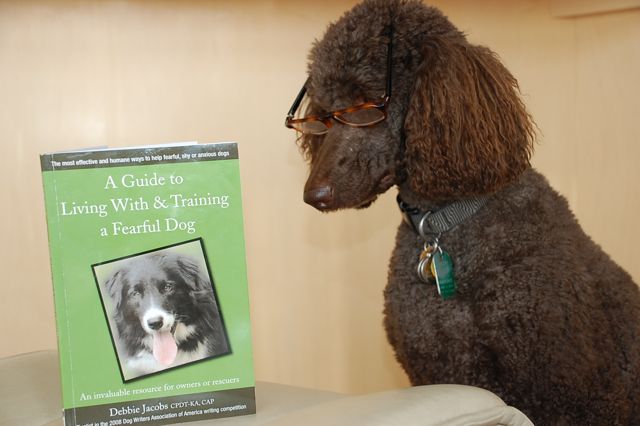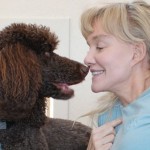I wish dogs could read. I especially wish fearful dogs could read. But, since they can’t, yet, (even though Sadie looks pretty convincing), you’ll want to read Debbie Jacobs’ A Guide to Living with & Training a Fearful Dog on behalf of the fearful dogs in your life.
Almost two years ago, soon after I starting blogging and Tweeting about my fearful Sadie, I found Debbie Jacobs‘ website and blog, Fearfuldogs.com and ordered her e-book, the precursor to A Guide.
Debbie has a gift for taking a dogs-eye-view. This is always a good idea if you love dogs, but absolutely essential if you live with a fearful dog. It’s one of the things I appreciate about Debbie. I know I can trust that what she has to tell me is in the best interest of my dog. That’s why I wish dogs could read. They would feel so understood by her.
Sunny, who graces the cover of the book, is a refugee from both Hurricane Katrina and a hoarding operation. He is the Border Collie that launched Debbie on her quest to discover how to make life as good as it can be for an extremely fearful dog. Debbie wrote the book she wishes she had had when she and Sunny began their journey together. Her Guide gives people with fearful dogs a much needed leg up.
There’s so much good information in this thin volume that I’m not sure where to start. So rather than try to cover the gamut, let me share some points Debbie made that hit home for Sadie and me.
Take stock of how you see your fearful dog. Do you harbor fantasies that your pup will snap out of it one day and turn into the doggie version of “Miss Congeniality”? Forgetaboutit. You’ll likely be disappointed. Adjust your expectations down a few notches for both your own and your dog’s sake. That way you’ll be thrilled by otherwise seemingly small achievements, like I was the first time Sadie didn’t duck and run for cover from a boy speeding past us on his scooter.
Do you think your fearful dog is being willfully aggressive, or worse, dominant, when she barks and lunges at the nice man who crouches over her and reaches out his hand to pat her on the head? I was mortified the first time Sadie did this. Thankfully, our trainer was wise. She, like Debbie, encouraged me to look at it from Sadie’s perspective. Sadie was freaked out. Panicked. Her behavior was reactive and not under her control. Sadie was screaming, “Go away! You scare me!”
What to do? First, do not punish your fearful dog, and do not force your dog to confront her fears.You’ll never earn your dog’s trust that way, and a fearful dog’s trust is golden. Once you earn it, never abuse it or take it for granted.
Debbie suggests using reward-based training to teach your dog skills to manage scary situations. Probably the most important skill Sadie has learned is “touch,” or “targeting” as Debbie refers to it, in which she bonks my hand with her nose. Now when Sadie sees someone or something that makes her uneasy she seeks out my hand for a “touch.” I always generously reinforce Sadie for choosing “touch” with a special goodie.
Change your dog’s brain! Debbie emphasizes that fearful dogs brains can, to varying degrees, be rewired. One way to do this is to help your dog change his fearful emotional reaction to scary things, such as people walking directly towards him.
This was one of Sadie’s triggers. Even if the person wasn’t really aiming for Sadie and just walking towards us, Sadie would freak. I wanted her emotional response to shift from “Yikes!” to “Yippie!” As Debbie recommends, I paired people heading towards Sadie with yummy treats. After many repetitions, people walking towards us predicted good things. Yippee!
All dogs wanna have fun, but fearful dogs gotta play. Another way Debbie suggests changing your fearful dog’s brain is through play. Joyful play releases feel-good brain chemicals such as dopamine. If you’re not sure what rings your dog’s bell, his breed might give you a place to start. For example, Border Collies are born to herd. Ain’t got sheep? Try big exercise balls. They’re great sheep stand-ins. Standard Poodles are water fowl retrievers. Tennis balls and frisbees are Sadie’s and my harmless substitute for dead ducks.
The bottom-line? “Any behavior you want your dog to learn should end up with your dog feeling good!”
I have but one quibble with A Guide to Living with & Training a Fearful Dog. I would have loved more stories about Debbie and her experiences with Sunny.











I’ve been working with a fearful pup for almost six years now – he’s come a long way, but I’d really like to check out Jacobs’ site and book! Thanks for sharing! 😀
Yea!! I’m so glad you got to review Debbie’s book. The advice and perspective she provides on her blog have been invaluable in training our Buster – a dog we found as a stray when he was about a year old. I can’t wait to get a copy!
[…] This post was mentioned on Twitter by Nancy Freedman-Smith, Deborah Flick, Deborah Flick, Rod Burkert, primitivedog and others. primitivedog said: RT @kimhalligan1: RT @boulderdog1 Fearful Dogs Everywhere–Rejoice! – http://bit.ly/dXg39s Review of @fearfuldogs new book! […]
Great books like these are never long enough, are they? I really wish I’d had this book two years ago when I adopted my dog. It would have helped immensely. But better late than never.
I, too, loved this book! I read it sitting next to my own fearful dog, Luna, who actually put her head ON my lap during the reading! She’s never done that before–I’ve had her 8 years. In any case, I loved Debbie’s approach in the book, and is definitely a must-read for all dog folks to truly understand what it’s like to be around one. Thanks for this review!
Aw. That’s so sweet. Every once in awhile Sadie puts her chin on my knee. I swoon.
For me, the hardest part was always balancing expectations for my fearful dogs. I did learn to notch down my expectations for them. But I sometimes think I too often expected them to respond fearfully and may have triggered their fears with my attitude.
Reading your review was the first time I thought about things I did to relieve my own personal shyness. You’re so right that the brain can be rewired (to some degree) with enough patience and effort. I would have never thought that the shy 15 yo I was would ever grow into a woman who leads workshops and lectures about 40 times a year. Yikes!
And you’ve certainly seen it with Sadie. Look at how much she surprised you at the Treibball competition!
No question. Our fearful dogs challenging teachers. I’m delighted for your own growth and that of all our dogs. 🙂
Thank you so much for this Deborah. It is nice to see Sadie & Sunny together (sorta).
You’re most welcome. I couldn’t tear Sadie away from it. She was totally engrossed.
Awesome stuff!
I just now found your comment as I was pruning my spam filter. So sorry.
I wish I hadn’t just ordered a bunch of books. I would have added this one to the list! It sounds like it would be an excellent read and very useful for working with my wuss dog. Though, from your bullet points, I’m doing a lot of the stuff the book suggests already. Still, I will have to add it to my wish list! Thanks for sharing your review!
Fearful dogs are a challenge, indeed. We have two. Chester is afraid of the wind, sometimes. Emily seems wary of everything around her. But, they are also affectionate and fun to be with. I wonder if this book shouldn’t be at every shelters and offered to every person who adopts from a shelter. Seems to me – many shelter dogs are fearful, with good cause. They need understanding and affection.
For instance, my niece is going through a disturbing situation with her shelter dog. She’s had the mixed-breed dog for four years and suddenly he displays serious “resource hoarding” tendencies. Is this part of being a fearful dog? How does she treat that? I had never heard of it, before.
Will this book help?
Are you familiar with Jean Donaldson? She used to head up the San Francisco ASPCA professional dog training program often referred to the Harvard of dog training. Anyway, she has written a book all about resource guarding called “Mine: A Practical Guide to Resource Guarding in Dogs.” I think you can find it at Dogwise http://www.dogwise.com/itemdetails.cfm?ID=DTB740. I hope this helps.
I second and third everything you wrote in this review; Debbie’s book is awesome. Thanks for letting more people know about it.
But no one has so far commented on the awesomeness of the picture of Sadie with the book, so allow me to be the first! Sadie looks like such a scholar.
Thank you! I love that photo too.
We will check this book out. When we adopted Kiska, she had been through so many things that she was very fearful. It took her days to feel comfortable around me and months and months to be ok in public. I used “The Cautious Canine” by Patricia B. McConnell Ph.D. as a great tool to understand what was going on in her mind. What has been fun is watching Kiska blossom as she continues to gain confidence in handling public encounters.
I relied on the Cautious Canine also and found it very helpful. Seeing our dogs gain confidence and grow to be more comfortable in the world is indeed gratifying. I’m glad Kilsa is doing so well.
Perfect photo! Looking forward to picking this book up. 🙂
Thanks!
[…] A Guide to Living With & Training a Fearful Dog was a finalist in the 2008 Dog Writers Association of America’s annual writing competition. The popular Ebook is now also available in hard copy. Our own chat moderator, Hilary Lane, offers a review of Debbie Jacob’s book at FangShuiCanines as does Deborah Flick of Boulder Dog Blog. […]
[…] Debbie’s book, A Guide to Living With & Training a Fearful Dog was a finalist in the 2008 Dog Writers Association of America’s annual writing competition. The popular Ebook is now also available in hard copy. Our own chat moderator, Hilary Lane, offers a review of Debbie Jacob’s book in her Fang Shui Canines Blog, as does Deborah Flick of Boulder Dog Blog. […]